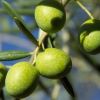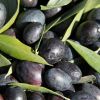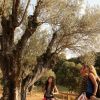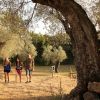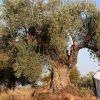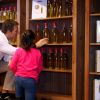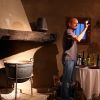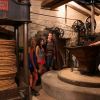Oleoturismo
Olive Oil Tourism

The olive and the production of oil are factors that contribute to the sustainability and development of Somontano. The heritage of the land gives cause to contemplate the biodiversity of the olive and its rich and historical past, and also provides the perfect excuse to taste exceptional oils; the true liquid gold of Somontano.
Modern industries live side by side with traditional oil mills. Thus, the past and present join together to provide top quality oil, made from genuine varieties, such as “alquezrana” and “verdeña”, and other better known ones, like “empeltre” and “blancal”, providing the cuisine with colour, aroma, personality and flavour.
Several mills offer guided tours of their facilities where see the process of obtaining oil and tasting it product.
Somontano olive oil also has a strong presence in the local hotels and restaurants.
Olives and biodiversity

Many centenary olive trees and groves with signposting and information panels are part of walking and cycling routes of the area such as:
- Viewpoint from the Santiago church. Bierge
- The olive grove of Monte del Barón (Walking Route of Azlor). Azlor
- The Mediterranean titrad (Ruta Leyendas al Paso): Adahuesca
- Nadal olive grove. Colungo
- Unique olive trees of El Grado
- Walk among the Alquezrana olive trees. Alquézar
In the Forest of Olives in Buera it is possible to see more than 18 different varieties of olives, many of which are indigenous and exclusive to the local villages.
Cultural heritage

To find out all about oil, its history and how it is made, you must visit the town of Buera. In the old olive mill (Torno de Buera), an explanation is given of all the beliefs attached to oil, and which are deeply rooted in the emotions of the people of the Somontano. The production process is also explained through the original parts (mill, weights press, decanters…), models and information panels.
In Salas Bajas, you can also visit (by appointment) the old mill (which ceased to function as such in 1979) and has become a vistor centre dedicated to the traditional olive cultivation.
In Barbastro there is a huge hundred-weight olive situated in the Calle Las Fuentes, similar to the one found at the olive mill of Buera.
The Crespillo festival is celebrated in Barbastro (as well as in other villages in Somontano) on the 25th March. A “crespillo” is a tasty, sweet pastry that is traditionally made on the day of the Incarnation with the aim of magically bringing fertility to the olive groves.
In the shrine of Nuestra Señora de Dulcis in Buera, children’s tongues are traditionally smeared with oil from the lamp of Our Lady, as it is said to give them a way with words. (2nd Saturday in May).


